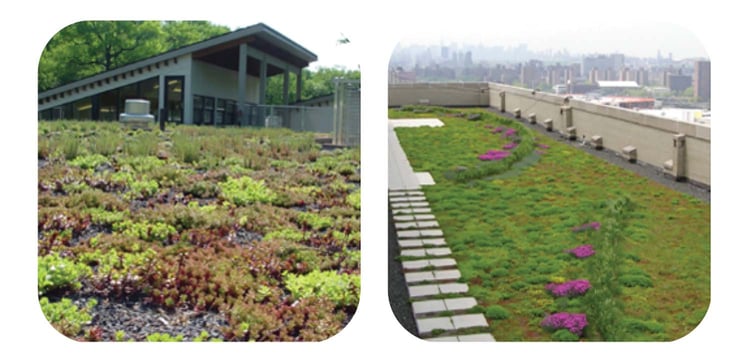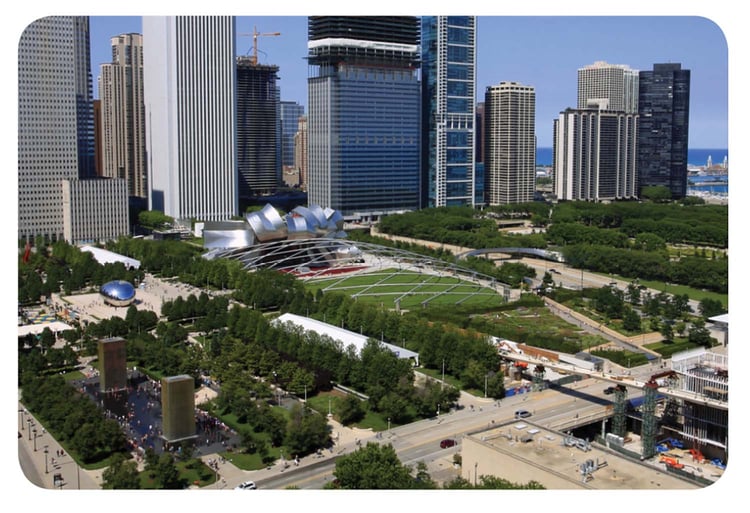UNDERSTANDING YOUR OPTIONS
Vegetated roofs offer multiple system types
There are many types of vegetated systems available in today’s market. To determine which system will work best for your vegetated roof project, you need to understand the different components of each. Are you looking to create additional green and living space for tenants in an apartment building or to simply meet stormwater management requirements in your city? There are several factors to take into account that can lead you to determine which system you need to install.
Vegetated roofs are often chosen based on their soil depth, structural requirements, and intended purpose and maintenance needs. There are three main types differ by cost, depth of growing medium and plant type.
Extensive Systems
Extensive systems, also known as compliance roofs, are considered the “work horses” of vegetated roofs. They provide a lightweight, low-maintenance solution and, as such, are the most specified and least expensive of all the vegetated roof options. Typically, this system is selected for large, flat-roofed buildings and is a good option for low-sloped roofs and retrofit styles. Installation methods can vary, but extensive roofs can often be installed in a very short period of time to provide an instant green effect.
Extensive systems are the shallowest type of system at three to six inches in depth and can weigh up to 42 pounds when saturated. This type of vegetated roof is not usually intended for general public access, rather, they are chosen mostly for their ecological benefits. Types of vegetation used on these roofs include sedums and certain drought-tolerant perennials and grasses. Typically, they do not require irrigation in most climates, except in the South and Southwest, as well as high desert areas.

Semi-Intensive Systems
Semi-intensive systems are a combination of both extensive and intensive types, providing a “best-of-both worlds” solution. This type of system opens up the plant palette tremendously. They include a richer, deeper substrate and drainage solution compared to extensive roofs, which enable the use of a wider range of plant mixtures. Perennials, taller grasses and even some small shrubs, can all be specified. This type of roof can also store and/or detain a lot of stormwater. Unlike an extensive system, it is quite common to see an irrigation system with a semi-intensive green roof.
These systems are six to ten inches in depth and many times defined up to twelve inches in depth. When they are saturated, semi-intensive systems can weigh up to 84 pounds. With deeper growing depths and the expanded plant palette, these systems offer much more design flexibility than extensive vegetated roofing.

Intensive Systems
Intensive systems are designed to replicate what is typically found at ground level in the natural landscape, as well as in green spaces like parks or cultivated gardens. You are likely to see intensive systems used on commercial buildings where owners want to have large green areas that incorporate all sizes and types of plants. They are made for those who have the time and the mindset to put in fully landscaped rooftop gardens, as well as those who do not mind the regular maintenance that it requires.
Intensive systems can include perennials, groundcovers, shrubs, trees and even turf grass, along with the proper irrigation system. Tables, benches, planter boxes, ponds, fountains and greenhouses can be installed on an intensive green roof to offer places for people to relax, dine or work in a picturesque park-like setting. As far as the irrigation and drainage systems are concerned, they must operate at peak efficiency to reduce the chance of overloading the roof’s structure.

LEARN MORE ABOUT VEGETATED ROOFING
What else should you take into consideration?
Understanding the system types is only one step in the design phase of a vegetated roof. Learn more about what to consider, maintenance requirements, and more from our additional resources.
Additional articles:
Contact a Sales Representative to Learn More
"*" indicates required fields
